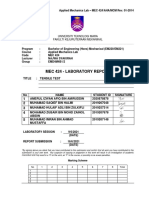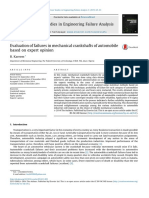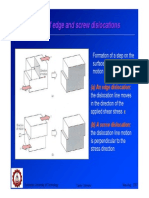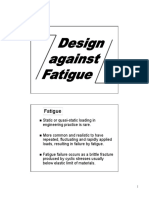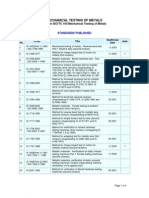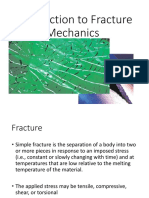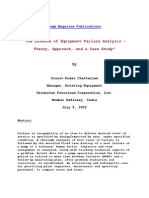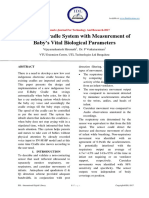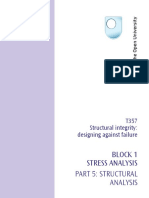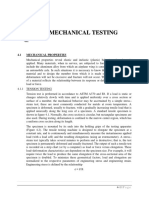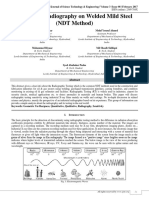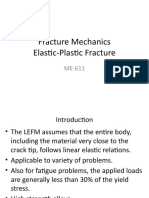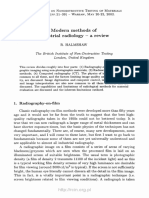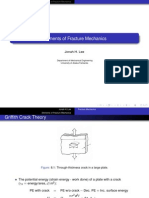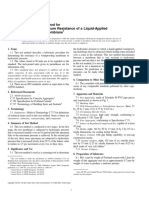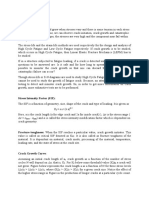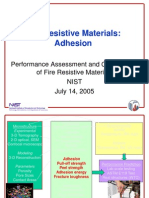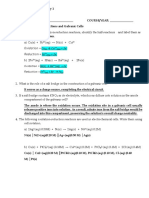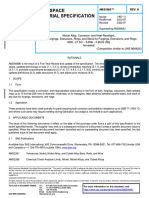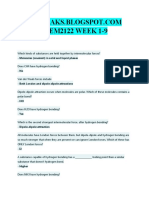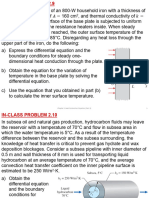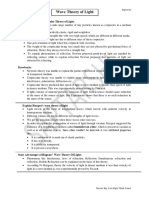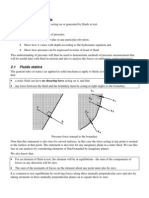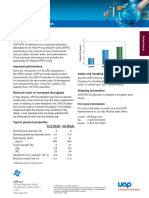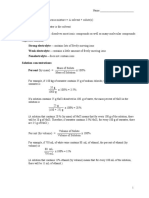Understanding of TWI J-R Curves
Understanding of TWI J-R Curves
Uploaded by
pcastlesmithCopyright:
Available Formats
Understanding of TWI J-R Curves
Understanding of TWI J-R Curves
Uploaded by
pcastlesmithCopyright
Available Formats
Share this document
Did you find this document useful?
Is this content inappropriate?
Copyright:
Available Formats
Understanding of TWI J-R Curves
Understanding of TWI J-R Curves
Uploaded by
pcastlesmithCopyright:
Available Formats
Understanding of TWI R Curves A method to measure fracture toughness
Shell contribution, Jan 7, 2009
Fracture Mechanics vs. Strength
The strength of materials approach Applied Stress The fracture mechanics approach Applied Stress Yield or Tensile Strength
Flaw Size
Fracture Toughness
Fracture Analysis
Two alternative approaches
-
Energy criterion approach
Gf = (2EWf/ a ) When Gf GfC, failure occurs
Stress intensity approach
KI = (a)1/2 When KI KIC, failure occurs
The two approaches are essentially equivalent for linear elastic materials
Materials Fracture Mechanics
Linear Elastic Fracture Mechanics Elastic-Plastic Fracture Mechanics Dynamic Fracture Mechanics Viscoelasti c Fracture Mechanics Vicoplastic Fracture Mechanics Linear TimeIndependent KIC Nonlinear TimeIndependent Critical J/CTOD TimeDependent
Effect of Material Properties on Fracture
Material High strength steel Low- and medium-strength steel Austenitic stainless steel Precipitation-hardened aluminum Metals at high temperature Metals at high strain rates
Typical Fracture Behavior Linear elastic Elastic-plastic/Fully plastic Fully plastic Linear elastic Viscoplastic Dynamic-viscoplastic
Driving Force Material Resistance Crack grows
Instability and the R Curve
R curve
-
Material resistance vs. crack extension Flat R curve - Material resistance remains constant Rising R curve - Material resistance varies with crack size Depends on how the driving force and resistance vary with crack size
Crack growth may be stable or unstable
-
R-Curves: Flat vs. Rising Curves
G, R G2 Unstable R Stable G1 a0 a0 ac G, R Instability Gc Gc
G4 G3 G2 R
G1
Crack size
Crack size
R: Resistance;
G: Driving force
Conditions for stable crack growth: G=R and dG/da dR/da Conditions for unstable crack growth: dG/da dR/da
Reasons for the R Curve Shape
For an ideally brittle material: flat
-
Surface energy is an invariant material property A plastic zone at the tip of the crack increases in size as the crack grows The material resistance is provided by the surface energy and local plastic dissipation.
For a ductile material: rising
-
For materials with cleavage fracture: falling
-
Industry Standards
BS 7448: Fracture mechanics toughness tests
-
Part 1: Method for determination of KIC, critical CTOD and critical J values Part 4: Method for determination of fracture resistance curves and initiation values for stable crack extension in metallic materials;
ASTM E 1820: Standard test method for measurement of fracture toughness.
Construction of R-Curves-Blunting and Exclusion
lines
Calculate the crack extension limit amax
-
Geometry dependent - amax=0.25(w-a0) for CTOD, or - amax=0.10(w-a0) for J
Same amax for a given geometry
Determine the slope of the blunting line
-
Material dependent (Yield & Tensile strength) - CTOD = 1.87x (tensile/yield0.2) x a Higher strength Steeper slope for - J = 3.75 x Tensile x a
Construct crack extension limit exclusion line
Minimum: 0.1mm - Maximum: parallel to the blunting line at an offset of amax
-
Construction of R-Curves-Data Spacing
Multiple specimen method
A minimum of 6 specimens - Each crack sector shall contain at least one data point
-
Single specimen method
Unloading compliance technique - Potential drop technique for crack extension monitoring
-
400
350
Recent TWI testing data
8630M/ AK10, bevelled (17860-W01) F6NM/ 625, square (Bodycot e)
300
250
200
410/ 625, square (17860-W02)
F22V/ 625, square (14403-W04)
Bodycote data
F6NM/ 410NiMo, square (18403-W04)
150
410/ 625, closure weld (17860-W03)
100
F22/ 625, square (14403-W05P) F22/ 625, square (14403-W06) 8630/ 625 BS3, square (Bodycot e) 8630/ 625 BS1, square (Bodycot e)
50
4130/ 625, square (14403-W07)
F22/ 625, square (14403-W05)
Early TWI testing data
8630M/ 625, square (14403-W02)
0 0 0.5 1 1.5 Crack Extension, a, mm 2 2.5 3
Limits
TWI R-Curves
250 240 230 220 210 200 190 180 170 160 150 140 130 120 110 100 90 80 70 60 50 40 30 20 10 0 0
Crack extension, a max CTOD BS7448-4 1.5 1.5 amax to be used
J 0.6 2??
Blunting line
F6NM / 625, square
J, N/mm
Predominantly cleavage + tiny patches of blue and green disbonding
Minimum exclusion line
8630M / 625, square
Maximum exclusion line
0.5
1.5 Crack extension, Da, mm
2.5
So, what do we know?
Interpretation of R-curves
Can be used for ranking material resistance to fracture in a given environment - The rising R curve is more ductile than the flat R curve - The higher end R curves are more resistant to fracture than the lower end R curves
-
Testing
TWI has partially followed BS7448 - The crack extension range has been shifted to the left - Bodycote uses a wider crack extension range - Validity??
-
So, what do we not know?
Interpretation of R-curves
-
How good is enough? What is the driving force? What is the valid crack extension range? How do we curve fit the data?
Testing
-
Tim-dependent Crack Growth and Damage Tolerance
Plays a role in life prediction of components
-
Fatigue Stress corrosion cracking
Failure
Flaw size
For instance da/dN = C (K)m
Useful service life
Time
Specimen Dimensions Required for a Valid KIC
Crack length (a) Thickness (B) Uncracked ligament (W-a)
Each of the above not less than
You might also like
- Tensile Test Experiment Lab ReportDocument78 pagesTensile Test Experiment Lab ReportAmerul izwan Amiruddin88% (8)
- Analysis Questions: Part 1Document3 pagesAnalysis Questions: Part 1Celyn Millano50% (2)
- Mae (256F) - HW2 PDFDocument6 pagesMae (256F) - HW2 PDFClaireNo ratings yet
- Bohm & The Implicate OrderDocument5 pagesBohm & The Implicate OrderHaris_IsaNo ratings yet
- Distillation Column DesignDocument24 pagesDistillation Column DesignBa Tawa Na100% (1)
- Circumferential Notched Tensile Testing For Correlation of The Stress Intensity Factor (KI) and Stress Corrosion Crack Growth RateDocument5 pagesCircumferential Notched Tensile Testing For Correlation of The Stress Intensity Factor (KI) and Stress Corrosion Crack Growth RateSinan ChenNo ratings yet
- Uncertainty Mech TestDocument9 pagesUncertainty Mech TestSanjay MehrishiNo ratings yet
- Chapter 4 EpfmDocument23 pagesChapter 4 Epfmwandee2393No ratings yet
- Evaluation of Failures in Mechanical Crankshafts of Automobile Based Onexpertopinion BDocument9 pagesEvaluation of Failures in Mechanical Crankshafts of Automobile Based Onexpertopinion BalanNo ratings yet
- Effect of Crack Orientation On Fracture Behaviour of Wire + ArcDocument9 pagesEffect of Crack Orientation On Fracture Behaviour of Wire + ArcviverefeliceNo ratings yet
- J-R BEHAVIOUR OF 20MnMoNi55 PRESSURE VESSEL STEELDocument107 pagesJ-R BEHAVIOUR OF 20MnMoNi55 PRESSURE VESSEL STEELramesh789No ratings yet
- 04 Plastic Deformation of Single Crystal-21-42Document22 pages04 Plastic Deformation of Single Crystal-21-42Aravind SomasundaramNo ratings yet
- Durability TestsDocument44 pagesDurability TestsBudigi Venkata Ramana PrasadNo ratings yet
- "Final Year Ece Projects in Chennai, Bangalore, Vijayawada, Kakinada." GoodDocument18 pages"Final Year Ece Projects in Chennai, Bangalore, Vijayawada, Kakinada." Goodwondi BETNo ratings yet
- ME2101E - Design Against Fatigue - BWDocument26 pagesME2101E - Design Against Fatigue - BWZhang DunJieNo ratings yet
- Material Failure TheoryDocument24 pagesMaterial Failure Theorystallone21No ratings yet
- Measurement of Prep Ene Trant EtchDocument6 pagesMeasurement of Prep Ene Trant EtchPDDELUCANo ratings yet
- Interpretation of An IndicationDocument2 pagesInterpretation of An IndicationAshfaq Khan100% (1)
- The Effect of Residual Stress and Crack Closure On Fatigue CrackDocument304 pagesThe Effect of Residual Stress and Crack Closure On Fatigue CrackTácito PicançoNo ratings yet
- Advances in Fatigue and FractureDocument248 pagesAdvances in Fatigue and FractureBrandon EricksonNo ratings yet
- Mechanical PropertiesDocument26 pagesMechanical PropertiesiqbalNo ratings yet
- MSE 280: Introduction To Engineering MaterialsDocument44 pagesMSE 280: Introduction To Engineering Materialsjains.boyNo ratings yet
- Evaluation of The Non-Linear Fracture Parameters J and C With ANSYSDocument11 pagesEvaluation of The Non-Linear Fracture Parameters J and C With ANSYSPeti KovácsNo ratings yet
- Liu - Fatigue Crack Propagation and Applied Stress Range - An Energy ApproachDocument7 pagesLiu - Fatigue Crack Propagation and Applied Stress Range - An Energy ApproachDavid C HouserNo ratings yet
- Kic Ctod시험법Document75 pagesKic Ctod시험법Naon KimNo ratings yet
- Ascometal Grades en PDFDocument8 pagesAscometal Grades en PDFJuan LeonNo ratings yet
- Fracture MechanicsDocument16 pagesFracture Mechanicskamal hameed tayyNo ratings yet
- ISO Standards On Mech Test of MetalsDocument4 pagesISO Standards On Mech Test of MetalsDaniel MoreNoNo ratings yet
- Fracture MechanicsDocument34 pagesFracture Mechanicsraees ahmadNo ratings yet
- FM (MEE84) Module-1 PresentationDocument29 pagesFM (MEE84) Module-1 Presentationsonic somannaNo ratings yet
- Determination of The J IntegralDocument15 pagesDetermination of The J IntegralJamalNo ratings yet
- Chapter 1 NDTDocument13 pagesChapter 1 NDTNurjihan Binti Aimi100% (1)
- Casting Inspection NDTDocument8 pagesCasting Inspection NDTdombipinNo ratings yet
- Little R E Mechanical Reliability Improvement Probability and Statistics For Experimental Testing Marcel Dekker 2001 PDFDocument595 pagesLittle R E Mechanical Reliability Improvement Probability and Statistics For Experimental Testing Marcel Dekker 2001 PDFMohamed AbdelAzizNo ratings yet
- Article Failure AnalysisDocument25 pagesArticle Failure AnalysisMd KalamuddinNo ratings yet
- Automatic Cradle System With Measurement of Baby's Vital Biological ParametersDocument7 pagesAutomatic Cradle System With Measurement of Baby's Vital Biological ParametersdbpublicationsNo ratings yet
- Chapter-10 Case StudiesDocument4 pagesChapter-10 Case Studiessafeer ahmadNo ratings yet
- Ebook t357 Block1 Part5 E2i1 n9780749252632 l1Document93 pagesEbook t357 Block1 Part5 E2i1 n9780749252632 l1Bobby extramoneyguyNo ratings yet
- Quiz 3 Solid MaterialDocument6 pagesQuiz 3 Solid Materialehsanzkr_499329029No ratings yet
- CHAPTER 2 LEFM Edited31Mac2014Document50 pagesCHAPTER 2 LEFM Edited31Mac2014wandee2393100% (1)
- Astm A751 21Document5 pagesAstm A751 21Chenjie Zhu100% (1)
- Chapter-4 Mechanical Testing 08-06-2014Document21 pagesChapter-4 Mechanical Testing 08-06-2014safeer ahmadNo ratings yet
- Welding PDFDocument6 pagesWelding PDFNavneet ChaubeyNo ratings yet
- Lecture 1 (Mechanical Behaviour of Materials)Document46 pagesLecture 1 (Mechanical Behaviour of Materials)Nazia ZamanNo ratings yet
- A Review of T-Stress and Its Effects in Fracture MechanicsDocument24 pagesA Review of T-Stress and Its Effects in Fracture MechanicsMarilene Lobato100% (1)
- Testing by Radiography On Welded Mild Steel (NDT Method)Document5 pagesTesting by Radiography On Welded Mild Steel (NDT Method)IJSTENo ratings yet
- Tensile Measure Single FiberDocument30 pagesTensile Measure Single FiberFeliciano Sinon100% (1)
- Tesis Sobre Integridad Estructural - Phased ArrayDocument8 pagesTesis Sobre Integridad Estructural - Phased Arrayrotero_pujolNo ratings yet
- Fracture Mechanics Elastic-Plastic FractureDocument59 pagesFracture Mechanics Elastic-Plastic FractureMansoor AhmadNo ratings yet
- Modern Methods of Industrial Radiology - A Rev1ewDocument19 pagesModern Methods of Industrial Radiology - A Rev1ewphanthanhhungNo ratings yet
- 01 - Fundamentals of Metalworking-2017son01Document92 pages01 - Fundamentals of Metalworking-2017son01emreNo ratings yet
- Non-Destructive Inspection Practical: NAME:-Amol Rajhans Talekar Roll No.: - Name of DepartmentDocument40 pagesNon-Destructive Inspection Practical: NAME:-Amol Rajhans Talekar Roll No.: - Name of DepartmentAniket DhoneNo ratings yet
- General Principles of Radiography BSEN 444 PDFDocument17 pagesGeneral Principles of Radiography BSEN 444 PDFThe Normal HeartNo ratings yet
- Holographic and Shearographic NDT Application in Aerospace ManufacturingDocument5 pagesHolographic and Shearographic NDT Application in Aerospace ManufacturingPDDELUCANo ratings yet
- Fracture Mechanics 2Document16 pagesFracture Mechanics 2Jagannadha ReddyNo ratings yet
- Creep and Stress RuptureDocument43 pagesCreep and Stress RuptureAlfiansyah DarmawanNo ratings yet
- Concepts of Fracture MechanicsDocument18 pagesConcepts of Fracture Mechanicsjs kalyana rama100% (1)
- ASTM C-1306 - Standard Method For Hydrostatic Pressure Resistance of A Liquid-Applied Waterproofing Membrane PDFDocument3 pagesASTM C-1306 - Standard Method For Hydrostatic Pressure Resistance of A Liquid-Applied Waterproofing Membrane PDFLeonardo Otto CoutinhoNo ratings yet
- Lefm NotesDocument8 pagesLefm NotesSolomon GracioNo ratings yet
- Creep & Superplasticity PDFDocument54 pagesCreep & Superplasticity PDFWahab AhmedNo ratings yet
- Bolted Flanged Joint: Flanges, Studs & Gaskets. Recommended Practices for the Assembly of a Bolted Flange Joint.From EverandBolted Flanged Joint: Flanges, Studs & Gaskets. Recommended Practices for the Assembly of a Bolted Flange Joint.No ratings yet
- Probabilistic Physics of Failure Approach to Reliability: Modeling, Accelerated Testing, Prognosis and Reliability AssessmentFrom EverandProbabilistic Physics of Failure Approach to Reliability: Modeling, Accelerated Testing, Prognosis and Reliability AssessmentNo ratings yet
- Fire Resistive Materials: AdhesionDocument30 pagesFire Resistive Materials: AdhesionChethan RaviNo ratings yet
- Assignment 6 Electrochem 1Document5 pagesAssignment 6 Electrochem 1Kester Yuree L. GimongalaNo ratings yet
- MSDS - Sheet Compresro Air VamntageDocument6 pagesMSDS - Sheet Compresro Air VamntageIvan Sazo QuinterosNo ratings yet
- Sae Ams 5666K-2022Document3 pagesSae Ams 5666K-2022hu1569076No ratings yet
- CHEMISTRYDocument3 pagesCHEMISTRYPisces SandNo ratings yet
- (AMALEAKS - BLOGSPOT.COM) CHEM2122 Week 1-9Document15 pages(AMALEAKS - BLOGSPOT.COM) CHEM2122 Week 1-9Jason NeighNo ratings yet
- Change of Particle Size Distribution During Brownian CoagulationDocument11 pagesChange of Particle Size Distribution During Brownian CoagulationPierre PradelNo ratings yet
- Maduracion OswaldDocument7 pagesMaduracion OswaldTHdezNo ratings yet
- Chap 1 Thermodynamics Exercise PDFDocument25 pagesChap 1 Thermodynamics Exercise PDFRanveer GautamNo ratings yet
- MPRWA DEIR Review 3 Brine DisposalDocument37 pagesMPRWA DEIR Review 3 Brine DisposalL. A. PatersonNo ratings yet
- 01 - New Water System 8page - +120-ENG YeniDocument8 pages01 - New Water System 8page - +120-ENG YeniIsmail BazzazNo ratings yet
- Biodiesel Production From Broiler Chicken Waste: John Abraham, Ramesh Saravana Kumar, Francis Xavier, Deepak MathewDocument4 pagesBiodiesel Production From Broiler Chicken Waste: John Abraham, Ramesh Saravana Kumar, Francis Xavier, Deepak MathewClasherr AddaaNo ratings yet
- Exp5Absorption Light in The MediumDocument5 pagesExp5Absorption Light in The Mediumفرقان كاظمNo ratings yet
- MCAE 410 Chapter 2 - Heat Conduction Equation - Part 3 (Problems)Document4 pagesMCAE 410 Chapter 2 - Heat Conduction Equation - Part 3 (Problems)ethan mackanickNo ratings yet
- Flashcards - Topic 12 Acid-Base Equilibria - Edexcel Chemistry A-Level - UnlockedDocument125 pagesFlashcards - Topic 12 Acid-Base Equilibria - Edexcel Chemistry A-Level - UnlockedDiyon JohnNo ratings yet
- Sample Notes 12th Physics II Chapter 10 and 11Document34 pagesSample Notes 12th Physics II Chapter 10 and 11A K GurjarNo ratings yet
- Journal of Molecular Liquids: Iman Nowrouzi, Amir H. Mohammadi, Abbas Khaksar ManshadDocument9 pagesJournal of Molecular Liquids: Iman Nowrouzi, Amir H. Mohammadi, Abbas Khaksar ManshadfirdaNo ratings yet
- Fluid at RestDocument25 pagesFluid at RestZinb HimdanNo ratings yet
- Battery Charging Current and Battery Charging Time FormulaDocument14 pagesBattery Charging Current and Battery Charging Time FormulaKaran ThombareNo ratings yet
- CHE+3054S+Solid+Fluid+Reactor+Design+ST+Ver+2+ Print-FriendlyDocument31 pagesCHE+3054S+Solid+Fluid+Reactor+Design+ST+Ver+2+ Print-FriendlynmhatityeNo ratings yet
- Sikalastic8200 Product Data Sheet-EnDocument3 pagesSikalastic8200 Product Data Sheet-EnesselamiNo ratings yet
- MS 13X Apg IiiDocument1 pageMS 13X Apg Iiijpjy9519No ratings yet
- PE 1000 SuperliningDocument2 pagesPE 1000 SuperliningASHOKNo ratings yet
- Ashrae Refrigerant Preso Nov 2019Document47 pagesAshrae Refrigerant Preso Nov 2019kdpmansiNo ratings yet
- Chemical Thermodynamics: Module - 4Document25 pagesChemical Thermodynamics: Module - 4TeachingTrainingCoaching KnowledgeSharingSessionNo ratings yet
- Mass of Solute Mass of Solution X 100%Document7 pagesMass of Solute Mass of Solution X 100%Sigrid Pristine De GuzmanNo ratings yet
- L1 - Crystals and Crystal Structures PDFDocument38 pagesL1 - Crystals and Crystal Structures PDFjhgNo ratings yet
